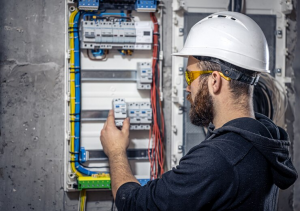Planning to attend a trade fair or show? You will need to decide on many things, including your stand design and placement. You can collaborate with experienced exhibition contractors or opt for a pre-designed solution, it’s your choice.
Just remember that the option you choose will affect how well your stand can draw in visitors and communicate your brand message.
From construction methods to placement strategies, this guide breaks down the primary types of exhibition stands to help you make an informed choice.
Stand Types Based on Construction
The type of construction has an impact on how your stand looks and functions, how well it fulfills its purpose, and your trade fair attendance goals. Here are the most common types of exhibition stands according to construction type:
1. Modular Stands
Modular exhibition stands use interchangeable, linkable, combinable components to create a flexible and reusable structure. Modular exhibition stand systems are ideal for businesses that actively participate in multiple shows every year but wish to balance cost efficiency with high-quality aesthetics.
The panels, frames, and connectors can be arranged in different configurations, making them suitable for various booth sizes and layouts. Modular booths are also quite lightweight, so you can transport them easily (and, thus, inexpensively) and assemble them effortlessly.
Key Features:
- Reusable for multiple events
- Easy to transport and assemble
- Customizable branding options with graphics and digital displays
2. Custom-Built Stands
Custom-built exhibition stands provide the greatest amount of creative freedom, as you can design them according to available space, the nature of the products you're exhibiting, or your brand.
Built by exhibition contractors according to specific concepts, custom stands allow you to create a booth with bespoke lighting, interactive displays, and specialized structures so the entirety of your exhibition is tailored to fit your brand, exhibition goals, and the amount of space you rent.
Custom-built stands naturally cost more and take longer to build than other types, but they typically create the most impact and are some of the most memorable booths in exhibition halls.
Key Features:
- Align the design to your brand
- Stand out with its innovative design, technology, and materials
- Reflect a specific brand image
3. Pop-Up Stands
Pop-up stands are compact and portable, so you should consider them if you’re attending a minor event in a smaller venue. It may also be for you if you have a tight budget.
Pop-up stands have a collapsible frame and fabric and graphic panels that you can attach securely to those frames. They are, of course, limited in customization, but they also require minimal effort to set up.
Key Features:
- Quick to set up and dismantle
- Affordable and lightweight
- Ideal for limited exhibition spaces
4. Shell Scheme Stands
Shell scheme stands are pre-designed booth frameworks. They’re usually provided by event organizers, specifically, the exhibition setup and show management contractor.
Shell-scheme stands provide all the exhibition essentials: the frames, walls, and floors. Also included are the lights and the electrical connections and outlets you’ll need.
You can enhance these components with your branding collateral, but they have limited flexibility in layout and design.
Key Features:
- Economical for first-time exhibitors
- Basic structure requiring additional branding
- Standardized dimensions across exhibition halls
5. Double-Decker Stands
Double-decker exhibition stands are multi-level structures that maximize the use of vertical space. Ideal for larger events, these stands provide additional room.
They are more expensive, but they’re also more functional, as you can designate the ground level as your primary exhibition floor and the second level as a small lounge or meeting room.
Key Features:
- Double the floor space
- Enable you to stand out
- Align with your premium branding
Stand Types Based on Placement
The placement of your exhibition stand within a venue impacts visibility, accessibility, and visitor engagement. Your location type, moreover, influences your choice of stand construction. For instance, custom-designed stands work better in island or peninsular configurations.
1. Island Stands
Island stands are accessible from all four sides, so they encourage the greatest amount of traffic. They are an excellent option if you need a high-impact booth.
Advantages:
- Maximum exposure from all sides
- Flexible layout options
- Ideal for showcasing large products or interactive installations
Consideration:
- Require substantial space and large budgets
2. Corner Stands
Corner stands stand at the corner (thus, their name), so they have two sides open to the aisles. They combine good visibility with a manageable footprint, so they’re a versatile option for businesses of all sizes.
Advantages:
- More visible than row booths
- Cost less than island stands
Consideration:
- Still offer a limited display area
3. Peninsula Stands
Peninsula stands have three open sides. They have two neighboring stands on one long side, but the three other sides are open to traffic.
Advantages:
- Accessible
- Offers more space
- Cost less than island stands
- Great for showcasing high-end products or services
Considerations:
- Cost more than a corner stand
- Requires thoughtful planning
4. Inline Stands
Also known as linear stands and row booths, inline stands have a single aisle-facing side open and three closed sides, each of which is bordered by a neighboring stand. They are common in smaller and denser exhibitions, particularly trade shows with a shell-scheme stand configuration or layout.
Advantages:
- Affordable and straightforward to design
- More manageable and more uncomplicated to design because there's only one point of access
Consideration:
- Restricted visibility because only one side is open
5. Endcap Stands
Endcap stands are positioned at the end of an aisle and have three open sides. Their placement naturally attracts foot traffic, especially in busy venues.
They're the same as peninsula stands but shallower. If an event has a 10 feet by 10 feet (i.e., 3 meters by 3 meters) standard booth size, a peninsula stand can occupy the equivalent of four individual spaces—a combination of two row booths and two corner stands; that's 20 ft by 20 ft (i.e., 6 m by 6 m).
Meanwhile, endcap stands are typically just two corner spaces combined. In the context of the above example, an endcap stand is likely 20 ft (6 m) on the long open side but only 10 ft (3m) on the shorter open sides.
Advantages:
- Enhanced visibility due to strategic location
- Suitable for creative designs and large graphics
Consideration:
- Cost more than corner booths
6. Customized Placement Solutions
Exhibition venues may allow for custom placement and cut sizes, such as outdoor areas or unconventional locations within the hall. Think of the custom exhibition stands in Dubai for Expo 2020. The stands in country pavilions did not conform to stereotypical placements as they were adapted to unique layouts.
Advantages:
- Distinctive placement
- Adaptable to niche branding needs
Consideration:
- Require advanced planning, collaboration, and custom work
Choosing Your Exhibition Stand
Deciding on the right construction and placement of your exhibition stand involves assessing your needs and the overall context where you will exhibit your brand, products, and services.
Modular and pop-up stands work well for budget-conscious exhibitors, while custom-built and double-decker stands deliver unmatched brand impact. Placement-wise, strategically positioned island, corner, endcap, and peninsula stands can draw more visitors and enhance engagement, but inline stands are the most affordable.






